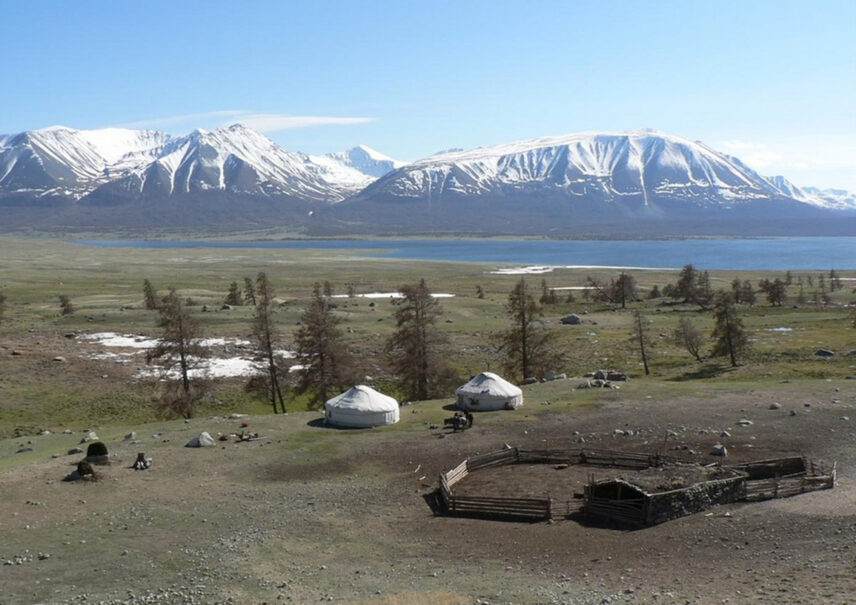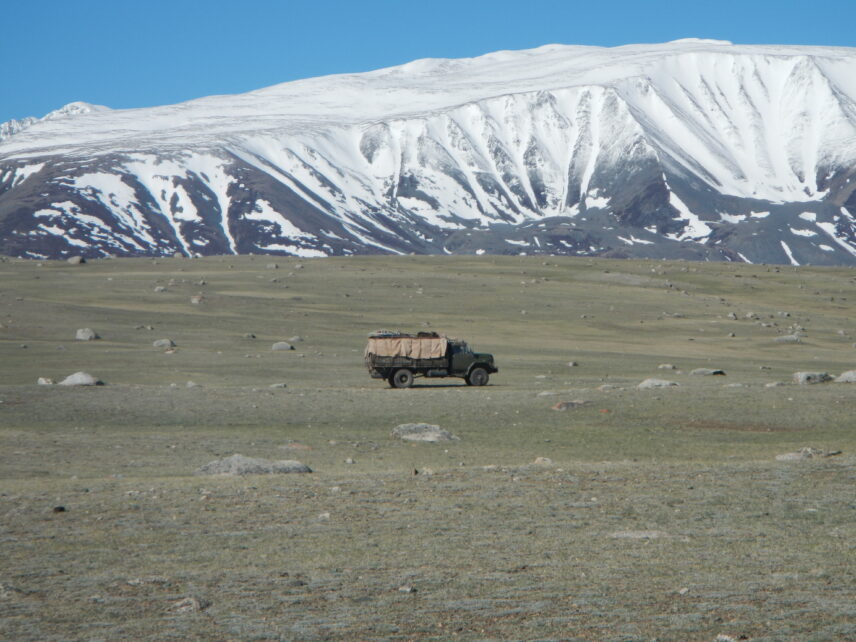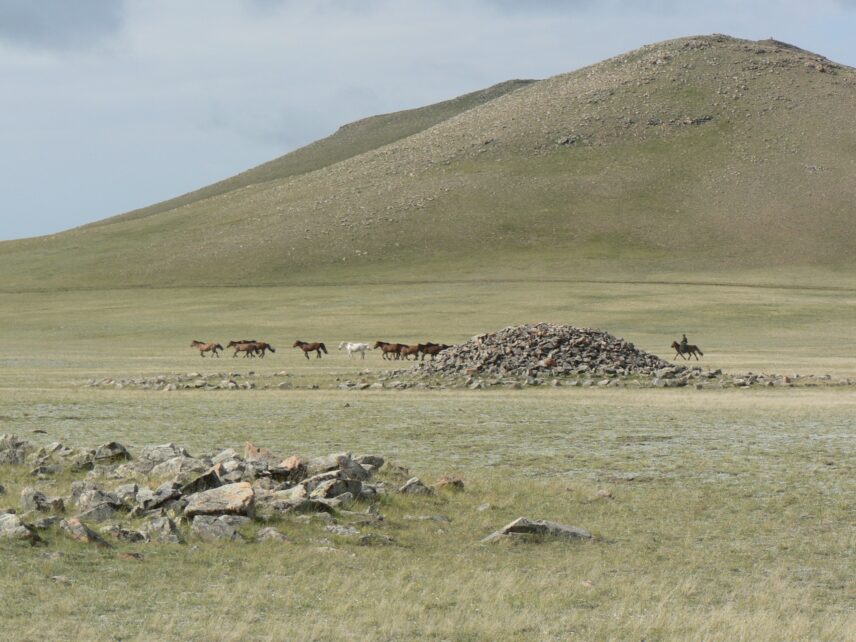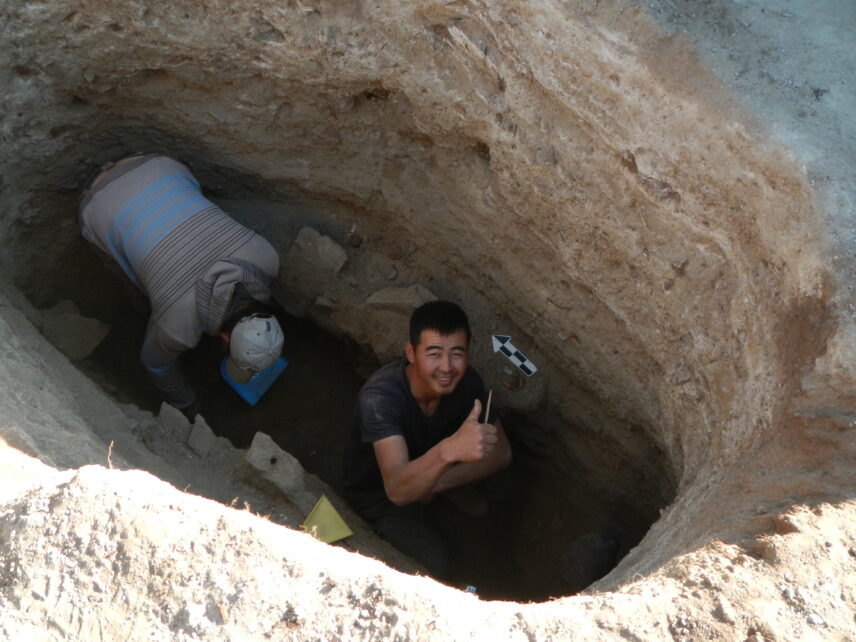Article begins
Back in 1909, Finnish archaeologist Sakari Pälsi became the first to document many of Mongolia’s iconic archaeological monuments. He travelled through the vast steppes on an expedition with the famous linguist G. J. Ramstedt, and along the way they recorded ancient sites, such as the 3,000-year-old Bronze Age khirigsuur burial mounds and deer stones carved with depictions of flying deer, as well as Mongolian pastoralist customs and folklore. Inspired by Pälsi’s journey, Oula Seitsonen and Jamsranjav Bayarsaikhan retraced their 1,000-mile-long route through the expansive landscape 110 years later, with the aid of some state-of-the-art archaeological methods.
While some of the monuments had been lost in the turmoil of time, and others recently reconstructed and reused as sacrificial sites, over 200 new archaeological sites were located along the way. These point to fascinating continuities in nomadic herder practices and rituals in the deep past and in the present, but also to some major changes in social and economic landscapes.
Together with Jean-Luc Houle we have been digging for Mongolian pastoralist heritage since 2010. Our archaeological surveys and excavations have highlighted the resilience of local herding lifeways in the face of numerous socioeconomic and environmental changes throughout the millennia.
Following in Sakari Pälsi’s footsteps
Mongolia is a pastoralist country. The majority of its immense landmass is used for herding purposes, and about half of its inhabitants are actively engaged in pastoral livelihoods on the steppes. It is a country of geographic and cultural contrasts, ranging from the snow-covered Altai Mountains in the west to the barren Gobi Desert in the east. The other half of the country’s population lives in and around its capital Ulaanbaatar, which is characterized by the juxtaposition of modern glass-walled skyscrapers and sprawling ger (yurt tent) neighborhoods. Migration from the countryside to the capital is also one of several threats to the durability of herding life in Mongolia and the cause of many socioeconomic problems, such as unemployment and displacement.

Pastoralist cultures in Mongolia have millennia-long roots. Owing to the sheer size and diverse geographies of the country, archaeological fieldwork is slow, costly, and patchy, and archaeologists have only recently started to uncover the remains of ancient herder settlements. There are still vast blank spots in the archaeological distribution maps. Also making strict research schedules and plans is typically pointless in Mongolia, as fieldwork is unpredictable, requiring great patience and a readiness to improvise.
Fieldwork in Mongolia habitually necessitates moving over great distances. Most places are without mobile phone connection, which demands preparedness to overcome all kinds of unanticipated challenges by oneself. The often-nonexistent infrastructure, unpredictable weather, and extremely long distances and travel times place great stress on vehicles, typically old and rundown Soviet vans and trucks. Pälsi and Ramstedt trekked their journey for three months on horseback, and although we managed to make the same trip in about half that time, it included seven car breakdowns, with improvised repairs sometimes in snowstorms, and driving through a flash flood that washed the tracks away.
It is not uncommon to experience all four seasons within a 24-hour period. You might wake up on an early June morning to warm summer weather that suddenly falls to subzero temperatures, then struggle through a snowstorm with eight-foot visibility through the day, before finally setting up camp in melting snow puddles. On some occasions, this weather cycle can even take place twice in a day. Strong winds, rain, and thunderstorms are common.
Travelling across the steppes is also a delightful experience that reminds us of human resourcefulness, friendliness, and goodwill. Navigation in the roadless terrain often takes places on a kind of macroscale, with just an approximate idea of the probable directions based on general landscape features such as mountains and valleys or following telephone lines. Of course, Global Positioning System (GPS) and satellite imagery assist in navigating but are often inadequate on a local level. In our experience, the traditional “Mongolian GPS” (Ger Positioning System), which involves accepting generous invitations to drink tea and eat with the herder families in their gers while asking directions, is often the most effective means to find your way across the steppes.

Pälsi and Ramstedt relied fully on the local ways of living, travelling, and clothing, and this is a useful approach even today. Horseback travel was and is a flexible, and sometimes the only, way to traverse the rugged terrain, as it has been for the past three millennia. The traditional gers offer a durable and comfortable choice for accommodation. And directions are best found by asking around and chatting with people.
In 1909, Pälsi became the first professional archaeologist to record many archaeological site types in Mongolia. During his trip, he developed field research techniques, such as photography and detailed mapping, which then formed a basis for Finnish archaeological documentation methods. Some decades later, he also wrote the first manual for archaeological fieldwork in Finland. A century on, many field methods in the harsh steppe conditions are similar to those used by Pälsi, coupled with state-of-the-art approaches such as drone mapping, laser scanning, and 3D-modelling.
Twentieth-century purges and nomadic revival
Besides archaeology, Pälsi and Ramstedt made insightful ethnographic observations and photographed the built environment, customs, religious beliefs, and herding practices of the people they met. We photographed many of the same places just over a century later to compare changes and continuities. The largest visible change in the Mongolian built environment and cultural legacy took place during the Great Repression―the Communist purges of 1937–1939 (in Mongolian, Их Хэлмэгдүүлэлт). During the purges, most of the Buddhist monasteries that had until that time acted as havens of civilization, culture, trade, and administration on the steppes were destroyed and nearly 20,000 monks were murdered. This caused massive changes in the socioeconomic dynamics, cultural environment, and spiritual and cultural heritage of the steppes. Many people were forcibly moved and resettled on collective farms, where rather unsuccessful attempts to farm the unsuitable steppe lands were made.
It was only after the collapse of Soviet Union in 1991 that Mongolians were able to revitalize their long-silenced religious legacy. They commenced a vigorous spiritual revival that included restoring their former sacred landscape, rebuilding temples, and uncovering many Buddhist treasures, such as statues and monastery gates hidden by locals in caves and wells since the 1930s. Ancient Mongolian shamanistic beliefs were also invigorated. This religious renewal has also included locals reconstructing some archaeological monuments recorded by Pälsi, which have been modified to become part of modern ritual complexes.
Today, many newly rebuilt temples and monasteries mark the Mongolian landscape. During our 2019 trip we were able to return the photographs taken by Pälsi in 1909 to some communities, who were able to witness for the first time these spiritual sites as they had been before their destruction. We also tried to locate the descendants of the shaman Ötsir-böö, immortalized by Pälsi in his world-famous photographs, but this turned out to be impossible owing to the large-scale relocations of people during Soviet times.

Alongside the spiritual restoration, the collapse of Soviet rule in Mongolia allowed people to get back to their traditional nomadic lifeways, moving out from the collective farms and spreading on the steppes in family and clan groups. Today, herders live in their gers and move according to an annual nomadic settlement pattern. Caravans between their summer and winter camps typically include the herders driving animal herds on horseback and their families following in old Soviet-built jeeps or trucks loaded with gers and other gear. The length of the annual migrations varies in different parts of the country depending on local conditions, from less than 10 miles to over 100 miles. This appears to have been the situation since Bronze Age times, based on our settlement pattern analyses.
Finding ancient pastoralist settlements
Past pastoralist habitation sites the world over are typically ephemeral and poorly visible, and appear to the untrained eye as an “invisible” archaeological record. Jean-Luc was among the first archaeologists to focus, about two decades ago, on Mongolia’s ancient herder settlement sites, starting in the Khanuy River Valley in north-central Mongolia.
Khanuy Valley was also visited by Pälsi and Ramstedt on their 1909 survey, which was one reason why Oula joined Jean-Luc and Bayarsaikhan there. The area is best known for Mongolia’s largest khirigsuur monuments, Bronze Age burial ritual sites that date to about three millennia ago and display a similar architectural vocabulary over great distances. Khirigsuurs exhibit a central burial mound surrounded by a rectangular or circular fence and have an array of characteristic satellite features, such as small sacrificial mounds on their eastern side that typically cover a horse skull facing eastwards and sometimes hooves, and on their western side stone circles containing burnt fragments of sheep or goat bones. Their general geographical orientation is similar across their large distribution area, suggesting the structures might have been oriented according to some celestial features. It seems possible that rituals at khirigsuurs were seasonal and related to nomadic migrations and to emerging social complexity since the Bronze Age. Especially fascinating, is the way that khirigsuurs continue to have a place in the local spiritual landscape and carry heritage importance and value for local people. For example, it is not uncommon to find recently sacrificed horse heads on top of these ancient burial mounds, telling of locals’ strong ties to these ancestral ritual sites.
The habitation site surveys in Khanuy Valley were based on a combination of ethnoarchaeology and systematically digging thousands of shovel probes over vast areas. The material dug up from the shovel probes, such as millennia-old ceramic sherds and faunal remains, allowed us to make a connection between the monumental landscape and ancient pastoralist seasonal mobilities between winter and summer campsites. In the past, the requirements for fitting seasonal settlement sites on the steppes were largely analogous to those of the modern pastoralists. These included suitable, water-absorbent soils on gentle slopes, protection from the harsh elements such as strong northerly winds, access to water and firewood, and, most importantly, good pasturelands. Modern pastoralist winter camps are typically situated in sheltered locations inhabited throughout the long Mongolian winter, which can last over half a year. Our studies show that many modern winter camps have acted as wintertime settlement sites for over three to four millennia.
Following the settlement pattern studies in the Khanuy Valley, we decided to test the lessons learned further afield. This was the starting point for our ongoing Western Mongolia Archaeology Project (WMAP). We shifted to work at the Altai Mountains in the westernmost tip of Mongolia at the border of Mongolia, China, and Russia in 2012–2014, and after that in the Züünkhangai region in northwestern Mongolia that was a blank spot in the archaeological distribution maps.

Deep pastoralist past
The most remarkable example of the lengthy and deep resilience of Mongolian pastoralist habitation was encountered at one of the sites we excavated in Züünkhangai. Altogether, we have recorded over 1,000 sites in Züünkhangai since 2015, ranging from Palaeolithic find locations that predate the last glaciation to ancient settlement sites, modern campsites, and sky burial places. Many Mongolians practice the ancient sky burial tradition, where a body is left to lie on the steppe so it can return into the great circle of life. Such sites are recognizable by their low grave markers and occasional scattered bones.
Most ancient habitation sites in Mongolia have little soil to excavate, typically only about a foot of archaeological deposits. This was what we anticipated to find also when digging a Bronze Age find location at one modern winter campsite, dubbed ZK513 (ZK refers to the study area and 513 is the running survey site number). After digging about a foot deep we noticed that the deposits at ZK513 kept on going, and as we continued exploring them, they just went on deeper and deeper. We reached the permafrost about three feet down, and in the end the archaeological layers reached nearly six feet deep!
Based on the radiocarbon dating of charcoal from various features and the material culture, these layers cover 4,000 years of recurring habitation at the same spot. Finds include ceramics connected to different periods of the past, lithic artefacts, and faunal remains in well-deposited contexts. Permafrost and the advantageous soils have preserved the find materials remarkably well. For instance, the bone finds are in excellent shape, which is very rare in Mongolia where archaeological bones are typically found in poor and fragmented conditions. The melting of permafrost and glaciers due to climate change is one of the major threats faced by archaeological materials in Mongolia.
ZK513 is the first such deeply stratified multiperiod pastoralist habitation site in Mongolia and an outstanding and unique example of the endurance of ancient herder lifeways. Based on geoarchaeological analyses by our colleagues Natalia Égüez and Juan José García-Granero and zooarchaeological bone analyses by Lee G. Broderick, we now know that the site acted as a pastoralist winter camp also in the past. The narrow valley at ZK513 with its protective cliffs on three sides and accessible pastures below has offered a good seasonal settlement site for herders through time. Our finds from ZK513 highlight the long-term adaptive strength of Mongolian herders over the past 4,000 years, despite major changes in their wider sociopolitical, socioeconomic, and environmental conditions.
The millennia-long use of same habitation and ritual sites is one of the most intriguing observations across the country and demonstrates continuities in land use, attachment to place, and the heritage value of past monuments for modern-day herders. This illustrates the robust resilience and day-to-day persistence of local herding practices, despite the coming and going of past and present empires, wars, pandemics, and nations in the wider world. This local-level long-term cultural endurance might also offer a key for the survival of Mongolian pastoralist lifeways in the turbulent twenty-first century.

